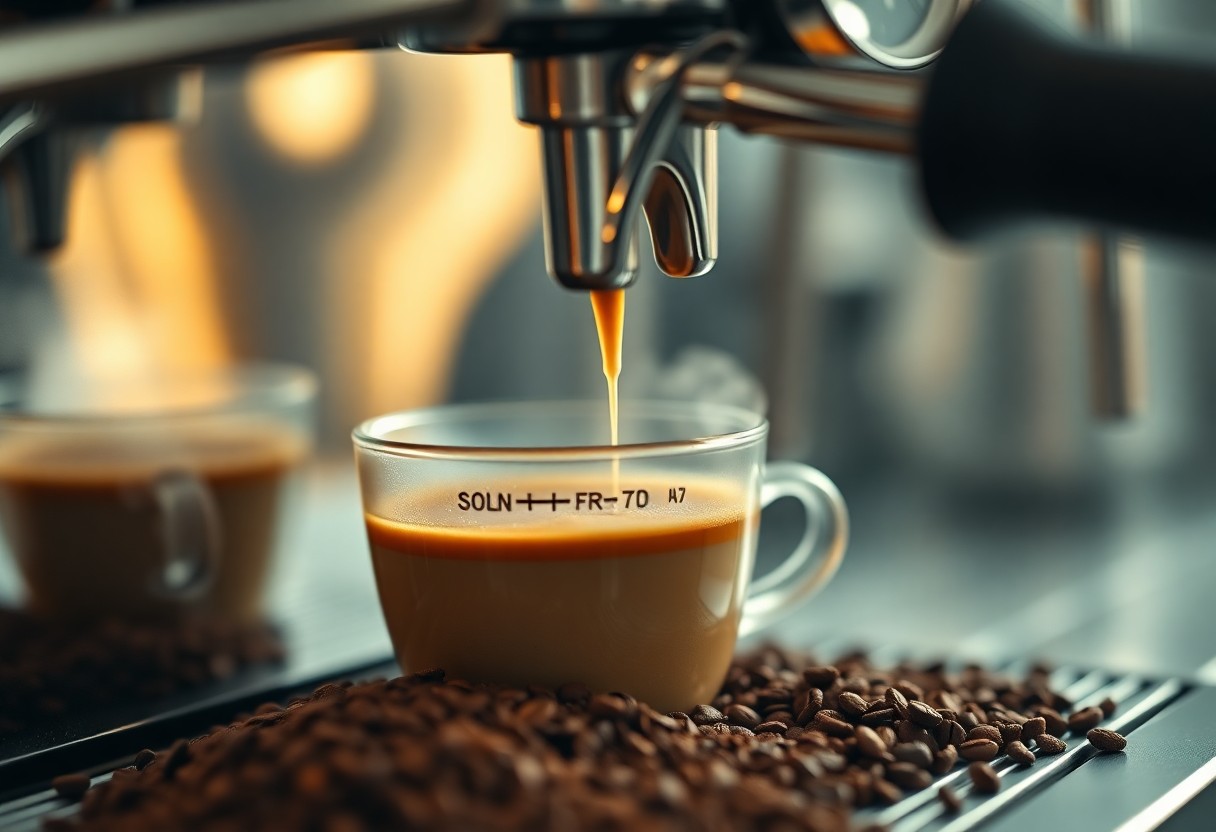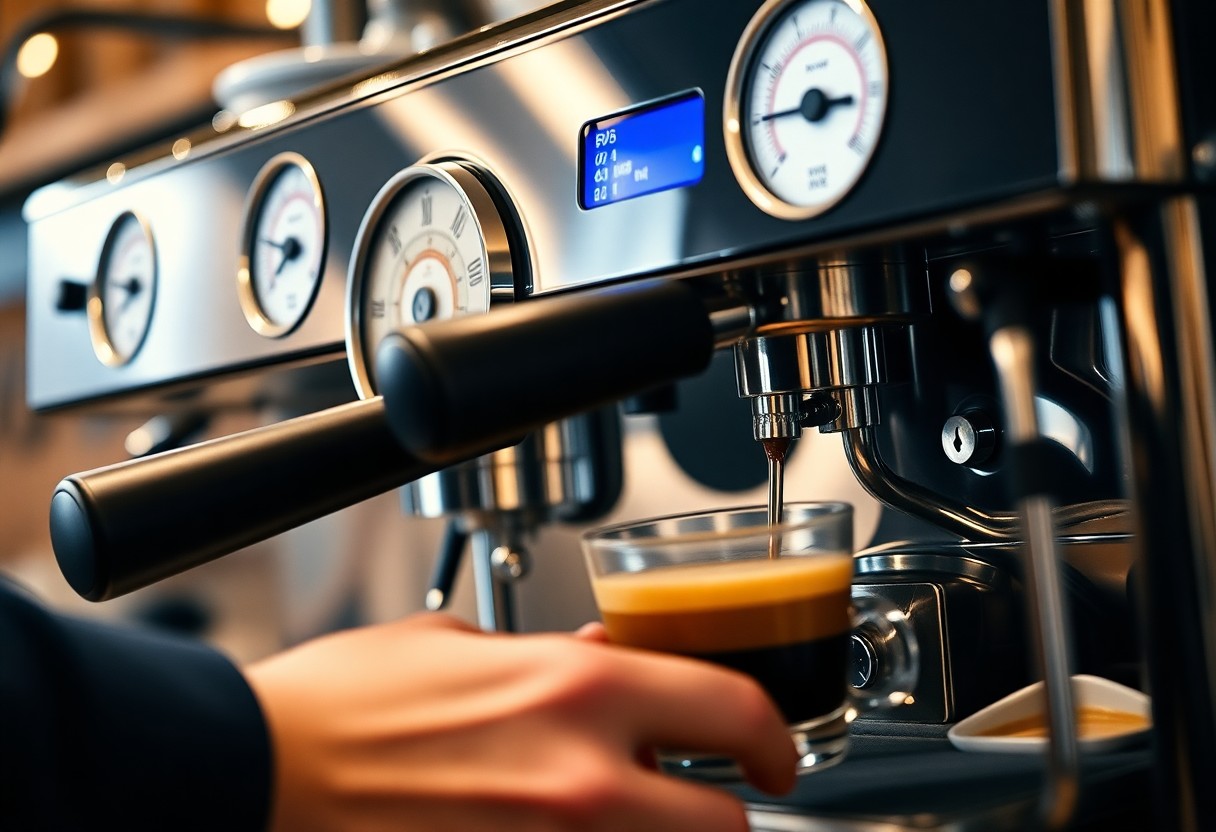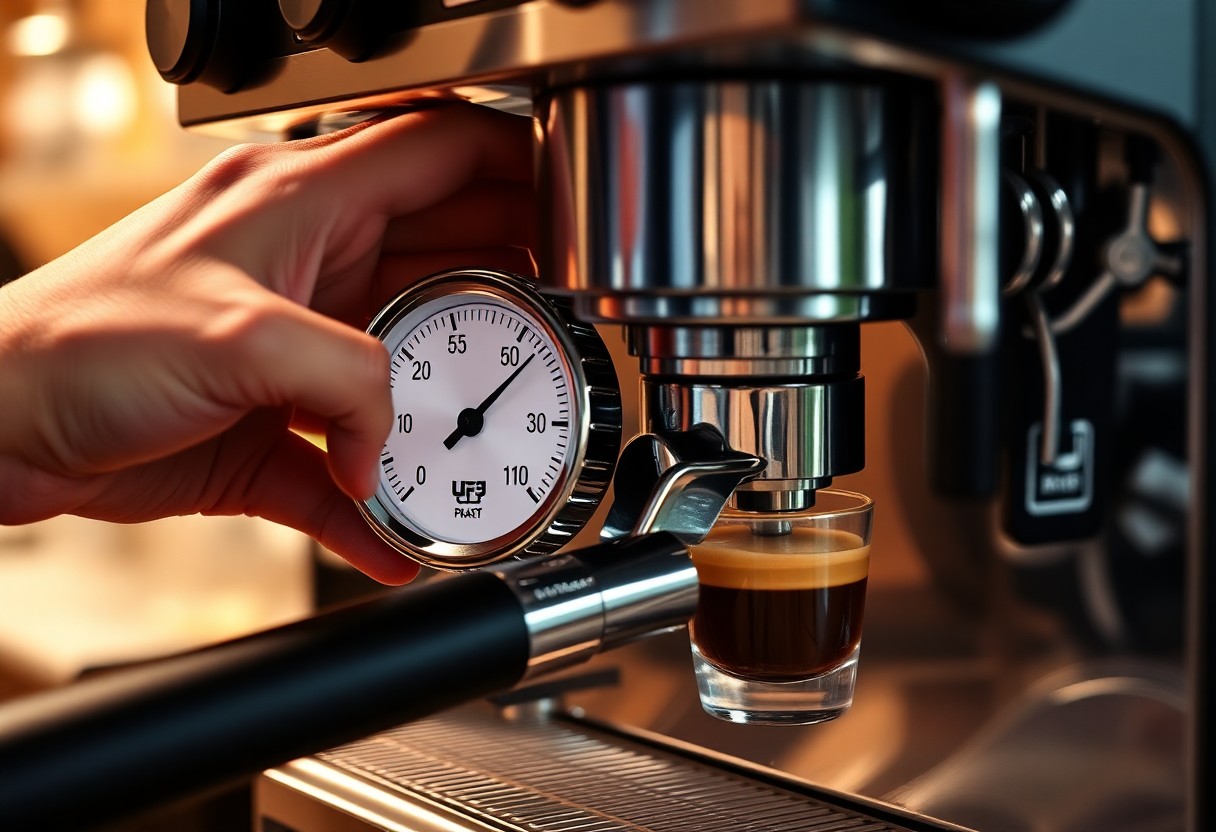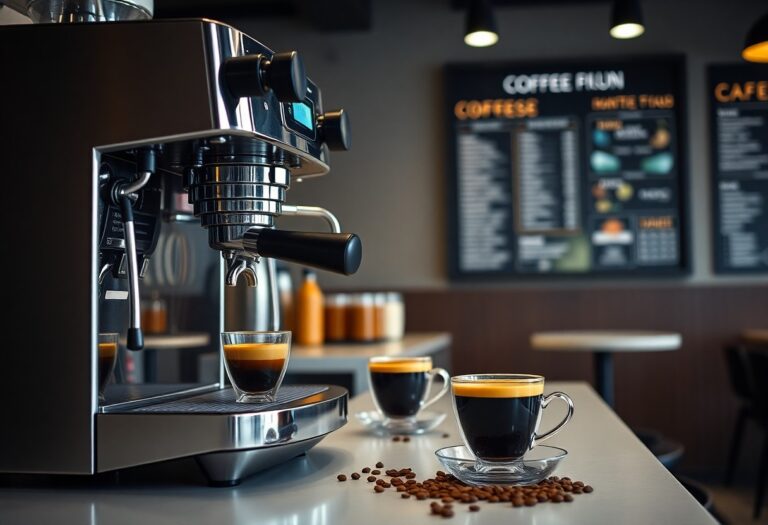What is Bar in a Coffee Machine – Pressure Measurement
There’s a lot more to brewing your favorite espresso than simply grinding beans and adding water; understanding bar pressure in your coffee machine can significantly impact your beverage’s quality. A bar is a unit of measurement that quantifies the pressure exerted during the extraction process. Typically, 9 bars of pressure is ideal for espresso, ensuring a balanced flavor and optimal crema. Without sufficient pressure, you risk under-extraction, resulting in a bitter and weak brew. This knowledge empowers you to fine-tune your coffee-making skills for a truly exceptional experience.
Key Takeaways:
- The bar is a unit of pressure commonly used in espresso machines to measure the force at which water is pushed through the coffee grounds.
- One bar of pressure is equivalent to the atmospheric pressure at sea level, roughly 14.5 psi (pounds per square inch).
- Espresso machines typically operate around 9 bars of pressure for optimal extraction, providing the ideal balance of flavor and crema.
- Understanding bar pressure is important for maintaining consistency in brewing; variations can affect taste and texture of coffee.
- Some advanced machines allow users to adjust bar pressure, enabling customization of the extraction process for different coffee beans and brewing styles.
The Role of Pressure in Coffee Extraction
Pressure plays a vital role in coffee extraction, significantly affecting the overall quality and flavor of your brew. When brewing espresso, a standard pressure of around 9 bars is applied to force hot water through the coffee grounds. This high-pressure process extracts soluble compounds from the coffee, including oils, acids, and sugars, which create the rich flavors and aromas you savor in your cup. Varying the pressure can lead to different extraction levels, impacting the balance and complexity of the final beverage.
How Pressure Impacts Flavor Profiles
Different pressure levels yield distinct flavor profiles in your coffee. Low pressures can produce a sour, under-extracted brew, while high pressures can lead to a bitter taste if over-extraction occurs. Achieving the right pressure not only enhances the sweetness and acidity of the coffee but also brings out the nuanced flavors that define its uniqueness. By experimenting with pressure settings, you can craft a cup that resonates with your personal taste preferences.
The Science of Coffee Solubility and Pressure
Understanding coffee solubility and pressure is necessary to mastering the brewing process. The solubility of coffee compounds varies with pressure, temperature, and time, influencing how quickly and effectively components dissolve into water. At higher pressures, certain oils and sugars that contribute to a fuller body and flavor richness are extracted more efficiently. This enhanced extraction is why many espresso enthusiasts prefer achieving that perfect 9-bar pressure during brewing, as it balances the flavors and body for a more enjoyable experience.
In the science of coffee solubility, each compound requires a specific amount of pressure to dissolve effectively. For example, acids and sugars are more soluble under pressure, leading to a bright and balanced flavor. Conversely, solubility limits mean that too much pressure can extract unwanted bitter compounds. Consequently, the relationship between pressure and solubility directly enhances your brewing technique, allowing you to fine-tune your espresso and achieve the desired flavor harmonics in each cup.
Decoding Bar Measurements in Espresso Machines
Understanding bar pressure in espresso machines is key to mastering the brewing process. The amount of pressure applied during extraction affects the flavor, aroma, and overall quality of your espresso. By decoding these measurements, you not only improve your coffee-making skills but also gain insight into achieving that perfect shot. Familiarizing yourself with various bar settings allows you to tailor your espresso according to your taste preferences while ensuring consistency in every brew.
What a Bar Represents: A Technical Perspective
A bar is a unit of pressure that equates to 100,000 pascals, and it’s the standard measurement for espresso machines. At sea level, one bar corresponds to the atmospheric pressure exerted by the air above us. In espresso brewing, nine bars is typically considered the ideal pressure for optimal extraction, influencing the water’s flow rate through the coffee grounds and affecting the resulting flavor.
The Ideal Bar Setting for Optimal Extraction
The benchmark for extracting a rich espresso lies at around nine bars of pressure. This setting allows water to flow evenly through the coffee grounds, ensuring a well-extracted espresso shot without over-extraction or bitterness. Achieving this pressure consistently relies on correctly calibrated machines and freshly ground coffee, making nine bars the sweet spot for a balanced flavor profile that highlights the coffee’s true character.
Maintaining nine bars during extraction plays a significant role in ensuring your espresso develops the right body and crema. If the pressure falls below this level, the water might flow too quickly, resulting in a weak taste. Conversely, excessive pressure can lead to overly bitter flavors and a harsh aftertaste. Mastering the science of bar pressure can transform your coffee routine, enabling you to recreate café-quality espressos right in your kitchen.

The Relationship Between Bar Pressure and Brew Time
During brewing, bar pressure has a distinct impact on your brew time. Typically, the optimal range for espresso is around 9 to 10 bars, which provides the necessary force to extract flavors efficiently. However, if pressure is too high, extraction occurs too quickly, leading to bitter flavors, while insufficient pressure prolongs brew time and results in under-extraction. For an in-depth exploration, check out What exactly does a brew pressure gauge measure?
Timing Your Extraction: The Pressure Equation
Extraction time aligns closely with the bar pressure setting on your machine. Generally, a brewing time of 25-30 seconds at approximately 9 bars produces a well-balanced shot. Adjustments in pressure directly affect the flow rate: higher pressure shortens extraction time, while lower pressure delays it, possibly sacrificing flavor. It’s crucial to strike the right balance between pressure and time to create the perfect espresso.
Understanding Pressure Drops During Brewing
As brewing progresses, pressure fluctuations may occur due to various factors such as coffee grind size, tamping technique, and water temperature. Understanding these drops is vital, as they can influence the extraction quality. Typically, a steady pressure is ideal, but if you experience significant drops, it can lead to channeling, where water flows unevenly through the coffee grounds, resulting in inconsistent flavors.
Monitoring pressure drops helps refine your brewing technique. For instance, using a finer grind can lead to higher resistance, creating a pressure drop that may result in under-extraction in some instances. Regularly check your machine and adjust the grind size or tamping method to maintain steady pressure throughout the extraction process, ensuring a consistent and flavorful shot with each brew.

Adjusting Bar Pressure: A Guide for Home Baristas
Fine-tuning the bar pressure of your coffee machine can greatly enhance the quality of your brew. Start by monitoring the brew pressure gauge during extraction; ideal pressure typically hovers around 9 bars. Adjusting it often requires tweaking the machine’s settings or the grinder’s coarseness. Experiment with small adjustments to pinpoint the best flavor balance, ensuring richer, more aromatic shots that highlight your coffee’s unique characteristics.
Tools and Techniques for Pressure Management
Investing in a reliable pressure gauge is crucial for managing your espresso machine’s bar pressure accurately. Additionally, a good quality grinder enabling fine-tuning of grind size allows for precise adjustments to extract optimal flavor. Utilize tools like calibrated tamper for even coffee distribution and try adjusting your tamping pressure, which directly influences how water flows through the coffee puck and can alter the pressure experienced during extraction.
Troubleshooting Common Bar-Related Issues
Experiencing inconsistent shots or low extraction could often be traced back to bar pressure issues. If your espresso is watery, check both the grind size and tamping consistency as they significantly impact the pressure buildup. Also, ensure your machine is fully heated; cold parts could lead to under-extraction. Regularly inspect for clogs in the brew head or the system, as blockages can hinder pressure performance.
To explore deeper into bar-related problems, consider calibration checks on your machine’s pressure settings and inspect the condition of your water supply. Variances in water hardness can impact the functioning of your equipment, affecting pressure over time. If your shots are too bitter, a too high bar pressure might be the culprit; conversely, under-extracted shots calling for adjustments could signal consistently low pressure. Documenting your brewing parameters can help identify trends and refine your technique, ensuring that you achieve consistently great espresso every time.
The Future of Coffee Pressure Technology
As advancements in technology continue to emerge, the future of coffee pressure technology promises to enhance both the quality of your brews and the efficiency of your machines. Features such as real-time pressure monitoring and automated adjustments will likely become standard, ensuring each cup meets your preferred specifications. You can expect machines that not only maintain consistent pressure levels but also adapt to various coffee types and brewing methods, offering unparalleled precision and personalization for every coffee enthusiast.
Innovations in Pressure Measurement and Control
New innovations in pressure measurement and control are reshaping how coffee is brewed. Devices equipped with advanced sensors provide detailed feedback on real-time barometric readings, allowing for minute adjustments that can transform the flavor profile of your coffee. With developments in AI, the capacity for machines to learn from previous brews means you can enjoy customized coffee experiences based on your past preferences.
The Impact of Smart Machines on Bar Precision
Smart machines are revolutionizing how bar pressure impacts brew quality. With integrated algorithms and machine learning, these devices can analyze brewing conditions and make instantaneous adjustments. For instance, if a machine detects a fluctuation in water temperature or grind size, it can automatically tweak the pressure to maintain your desired extraction levels, leading to more consistent and flavorful cups.
The precision offered by smart machines is invaluable, enabling you to achieve exact settings that align with your taste profile. Devices like the Breville Oracle Touch have showcased this technology, featuring built-in sensors that monitor bar pressure throughout the brewing process. This ensures that the optimal pressure is maintained, even if variables like humidity change. With the ability to connect to mobile apps, these machines can continually learn and adapt, allowing you to refine your brewing technique over time and achieve professional-level brews effortlessly.
To wrap up
Hence, understanding bar pressure in your coffee machine is important for crafting the perfect brew. It dictates how water interacts with the coffee grounds, directly influencing flavor extraction and overall quality. By monitoring and adjusting the bar pressure according to your machine’s specifications, you can enhance your coffee-making experience and ensure a consistently delicious cup every time. With this knowledge, you are better equipped to make informed decisions that will elevate your brewing skills.
FAQ
Q: What is the function of a bar in a coffee machine?
A: The bar in a coffee machine refers to the measurement of pressure used during the brewing process of espresso. It indicates the amount of pressure that the water is forced through the coffee grounds. Usually, a pressure between 8 to 9 bars is optimal for brewing espresso, allowing for efficient extraction of flavors and oils from the coffee.
Q: Why is pressure measurement important in coffee brewing?
A: Pressure measurement is vital in coffee brewing as it affects the extraction process. The right amount of pressure helps to extract the flavors, aromas, and oils from the coffee grounds, leading to a balanced and rich taste in the final cup of coffee. Insufficient pressure can lead to under-extraction, resulting in a sour taste, while excessive pressure can cause over-extraction, leading to bitterness.
Q: How does a coffee machine generate pressure?
A: Coffee machines generate pressure using a pump, which can be either a vibration or rotary pump. The pump forces hot water through the compacted coffee grounds at a specified pressure. This process is crucial for brewing espresso, where the water needs to interact with the coffee grounds efficiently to produce a quality shot.
Q: Can I adjust the pressure in my coffee machine?
A: In some coffee machines, particularly higher-end models, users can adjust the pressure settings. This feature allows for customization of the brewing process to suit individual preferences and different coffee bean types. However, many coffee machines come preset at optimal pressure levels, and adjustments might require knowledge of the machine’s operation and maintenance.
Q: What happens if the pressure is too low or too high in a coffee machine?
A: If the pressure is too low, the extraction process can become inefficient, leading to under-extracted coffee that may taste watery or sour. Conversely, if the pressure is too high, it can create over-extraction, resulting in a bitter and harsh flavor. It’s crucial to maintain the right pressure for a balanced and enjoyable coffee experience.







